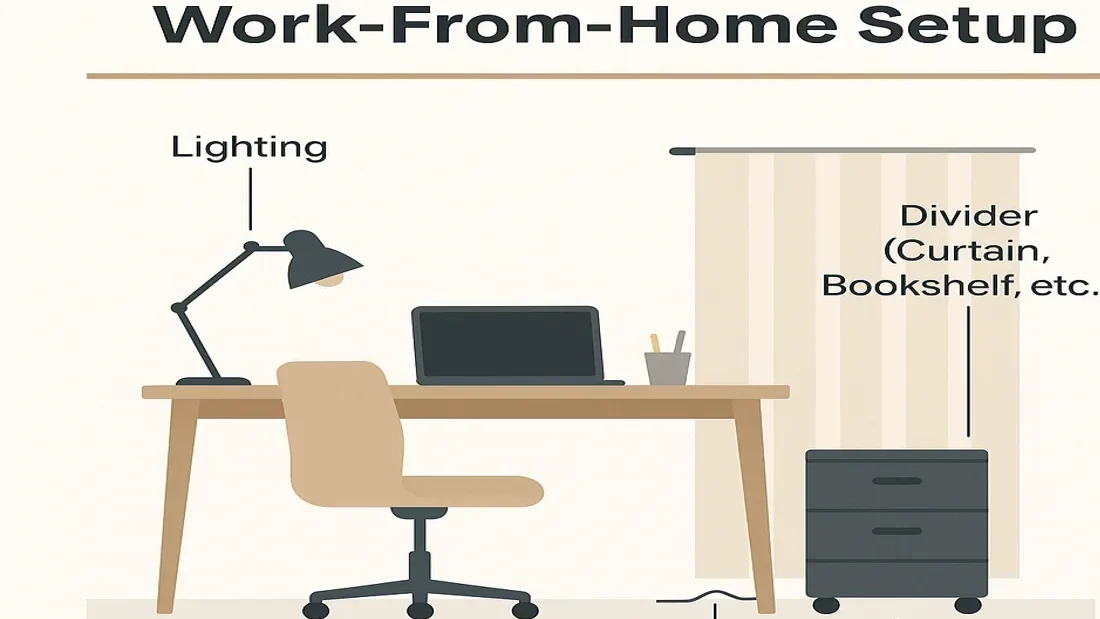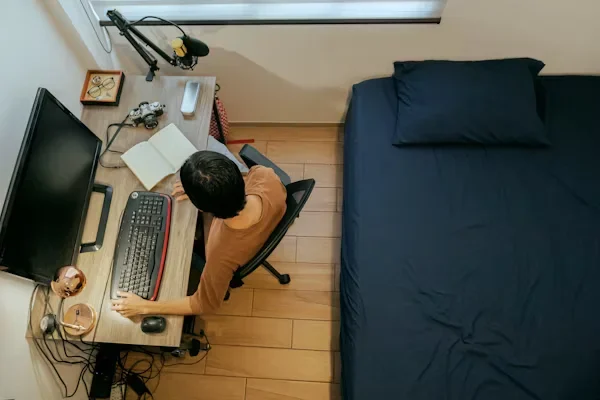Remote work can feel like a dream until you’re juggling Zoom calls while your roommate blends a smoothie in the kitchen. Boundaries blur fast when home becomes your office and shared living space. But with a few clever hacks, you can turn even the most chaotic roommate situation into a productive workspace.
Home Office Hacks When Living With Roommates
Define and Divide Your Work Zone

When you live with others, personal space is precious. Start by carving out a specific area for work. It doesn’t have to be a whole room; even a quiet corner will do. Use folding screens, bookshelves, or curtains to visually section off your space. If you don’t have room for permanent dividers, use rugs or lighting to define your “office” space.
If you’re working in your bedroom, avoid setting up your workstation on your bed. Use a desk or table to create a mental separation between work and rest.
Come Up With a Noise Policy (Without Being a Buzzkill)
Noise is one of the most significant issues for remote workers living with roommates. Overlapping meetings, late-night video game marathons, or unmanaged noise levels can quickly cause friction in a household.
Discuss a mutual quiet time agreement during your working hours. Use apps like Google Calendar to share your meeting schedule, or a simple whiteboard on the fridge to block out “do not disturb” periods.
If agreements alone aren’t enough, invest in noise-canceling headphones or a white noise machine. They’re game-changers for focus and mental clarity.
Quick Do’s and Don’ts for Shared Living Harmony:
| ✅ Do | ❌ Don’t |
|---|---|
| Use noise-canceling headphones | Assume silence will happen naturally |
| Set visual cues | Expect roommates to guess your schedule |
| Rotate shared spaces fairly | Dominate communal work zones |
Set Boundaries Early and Often
Assuming your roommate knows you’re working on a deadline without communicating it, it’s a fast track to frustration. Schedule weekly check-ins to discuss your work needs, shared chores, and mutual expectations. A simple “Hey, I’ve got back-to-back calls from 9 to 1 tomorrow” can go a long way.
Keep It Tidy

A cluttered space leads to an untidy mind. If your kitchen doubles as your work zone, tidy up after every use. Set ground rules around shared areas like the dining table or living room, especially if you’re rotating between spaces.
Storage hacks can help prevent your supplies from taking over shared areas. Stow your equipment in rolling carts or stackable bins when you’re not using it. That way, your workspace can disappear after hours, keeping the peace.
Rotate Rooms, If Possible
Consider a weekly or monthly rotation of shared workspaces if your apartment allows it. For example, you can claim the dining table this week while your roommate gets the living room. Swapping keeps things fresh and avoids ownership disputes over prime work zones.
If one roommate has a private space while others don’t, consider a fairness system: use of the quiet room rotates during peak deadlines or client calls.
But if your current living situation isn’t cutting it, it might be time to consider a better match (or more space). Use platforms like SpareRoom to find a roommate in San Francisco, Austin, LA, New York, or anywhere else in the US who fits into your lifestyle and vice versa.
Use Visual Cues
Sometimes you don’t need words to communicate your availability. Use a visual cue system to signal when you’re busy. For example, a simple red-green card outside your door can let your roommate know when it’s OK to come in and chat and when it’s time to keep quiet.
Plan for Breaks Outside the Home
Burnout is real when your workplace is also your living room. Break the cycle by planning your breaks outside, whether a coffee run, a walk around the block, or working from a local cafe for an hour or two. This allows your roommate to use the space and helps you reset mentally.
If you both work remotely, alternate schedules for communal areas to give each other breathing room.
Create a Compact Setup

Less space doesn’t mean you can’t have a functional and inspiring setup. Compact furniture like wall-mounted desks, foldable chairs, or under-desk storage can go a long way. If you’re short on ideas, The Spruce has a great roundup of creative home office setups tailored for small spaces that are stylish and practical.
Laptop risers, wireless keyboards, and dual-use lighting (task and ambient) can all make your setup feel intentional without dominating the room.
Also, consider ergonomic choices. An uncomfortable chair or bad lighting can make long days unbearable. A few thoughtful purchases can improve your comfort and productivity.
Be Flexible and Empathetic
At the end of the day, living with roommates while working remotely is about compromise. Maybe they’re not thrilled about your 7 a.m. calls, just like you aren’t keen on their evening drum practice. The key is mutual understanding and small adjustments that benefit everyone.
Recognize that everyone is doing their best, and your flexibility will often be returned in kind.
Final Thoughts
Remote work offers freedom, but sharing a home with others can test your patience. You can thrive in your shared space with the right mix of boundaries, communication, and clever solutions. Small changes can significantly impact your day-to-day comfort and productivity, from rotating rooms and defining noise rules to finding a new roommate through platforms like SpareRoom. When your home office actually works, remote life really can be the best of both worlds.












